What's Good: Significantly improved design over the original Bold, fantastic keyboard, great battery life, and admirable call quality.
What's Bad: The web browser, though improved, is still no comparison to competing smartphones on the market.
Yes, it's a love or hate characteristic, but RIM is a historically conservative company when it comes to design changes, and the Bold 9700 is no exception. As a replacement to the aging BlackBerry Bold 9000, the Bold 9700 (also referred to as "the Bold") ushers in new design cues, and adds notable improvements such as the trackpad, Wi-Fi, a 3.2-megapixel camera, and OS 5.0.0.330. Marking the first T-Mobile 3G BlackBerry, their version supports UMA support for Wi-Fi calls through the carrier's Hotspot@Home service. As much as I loved the original Bold's design, I love the Bold 9700's even more, as it fits in my hand with the smoothness of the Curve, but offers the premium features expected from the Bold product line. The winning feature about the Bold 9700 is not that it's a radically new design, but that they've improved upon the issues that plagued previous models to make a truly great device.

With the Storm2, Bold 9700, and the Curve 8530 landing on retail shelves this season, it's clear that RIM is pursuing a new design direction. Departing from the bulky design of the Bold 9000, RIM's new design approach appears to involve beveled edges and tapered corners. The left side of the device houses a 3.5mm headphone jack, microUSB charging port, and a shortcut key, while the right side sports a volume rocker and a second shortcut key. The front of the device sports a trackpad, QWERTY keyboard, and a dedicated row containing send, 'BlackBerry,' back, and end keys. On the top of the phone, a lock button and mute key can be found. The camera is located on the back, and the microSD card slot is located under the battery cover in the top-center area of the device. Both shortcut keys on the left and right sides of the phone are completely customizable, and have migrated away from the chrome accents in favor of a rubberized texture. For legacy Bold lovers, RIM added the faux leather to the battery cover on the Bold 9700, as well as a "Bold" moniker between the camera lens and flash.
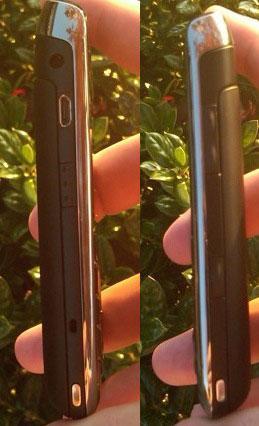
RIM didn't skimp out, as the Bold 9700 offers quite a few accessories when compared to other smartphones in the category (and even with other BlackBerry devices). The package includes the device, battery, charger, USB cable, holster, earphones, and a 2 GB microSD card preloaded in the phone. Coming in at 2.36 inches wide by 4.29 inches long by 0.56 inch thick, the 9700 weighs in at 4.3 ounces, which is relatively light for a fully featured smartphone. The 2.4-inch QVGA display houses 65,000 colors and 480 x 360 pixels. Like most of the BlackBerry devices launched in the past year, the screen is an absolute pleasure to deal with. From checking e-mail to viewing pictures, colors are incredibly vibrant and rich. Though the Bold 9700 is said to have a 624 MHz processor like the original, the 9700 is noticeably faster in all tasks I threw at it. There is no wait time with any task.
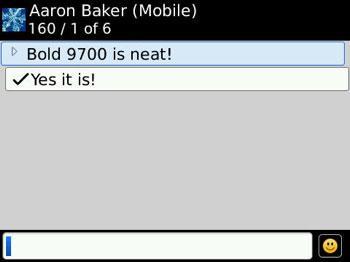
The Bold 9700 ships with OS 5.0, which offers threaded text messaging out of the box.
Though not drastic in terms of a revision, BlackBerry users will immediately notice changes in OS 5.0.0.330, which is what the Bold 9700 ships with. Featuring threaded text messaging and a refined 'home' page, OS 5.0 boots up faster (a common frustration among BlackBerry users), and offers a list of small improvements over previous builds such as revamped icons, an updated web browser with several improvements, and a refreshed "applications installed" menu. The threaded text messaging was something we saw coming, but it's nice to have a second retail unit that supports it out of the box (Storm2 was the first retail OS 5.0-enabled device).
As with any BlackBerry, the menus are largely customizable, and can be tailored to the user's specific needs. Visual voicemail comes preloaded on the T-Mobile version of the Bold 9700 (I'm assuming it does on AT&T's, as well), along with T-Mobile's web2go WAP browser, and numerous social networking programs: AOL Instant Messenger, Google Talk, ICQ, Yahoo! Messenger, Windows Live Messenger, and BlackBerry Messenger. Popular apps such as Facebook and Poynt can be downloaded from the BlackBerry App World.
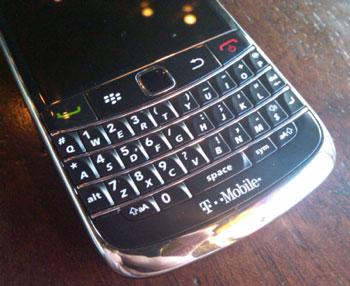
Reminiscent of the 9000, the Bold 9700's keyboard is spacious and a pleasure to use.
Heavy text messaging users, e-mail junkies, and the like will absolutely delight in the BlackBerry Bold 9700's QWERTY keyboard. I loved the Bold 9000's keyboard, but was frustrated at times by the size of the unit itself, particularly when more attractive models such as the Tour 9630 and Curve 8900 entered the market. The keyboard on the 9700 is absolutely phenomenal, and I'm pleased to say that the Bold 9000's general key size carried over to the 9700 (I'm sure there's some small size difference, but it's negligible). The 9700's keys are slanted at less of an angle, making it easier to type versus other models like the Tour and Curve.
The 9700 is the second BlackBerry to ship with a trackpad instead of a trackball, and as if it wasn't obvious, RIM executives tell me that's where they're all headed. To be candid, I think it's a fantastic idea, as the trackball has quite a notorious reputation. The Tour had some issues at launch with the trackball, and most BlackBerry owners will tell you that the trackball becomes harder to use as the years go on. Though it takes a few hours to adjust to it (and consequently, to go back to the trackball after the fact), using the trackpad is a delight. It's incredibly easy to use, and adds to the sleek profile of the phone.
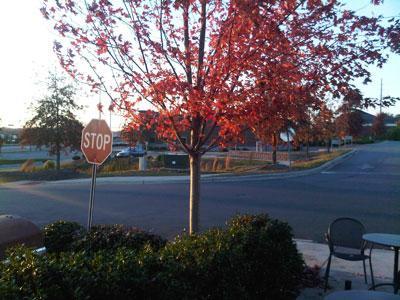
With sufficient natural light.
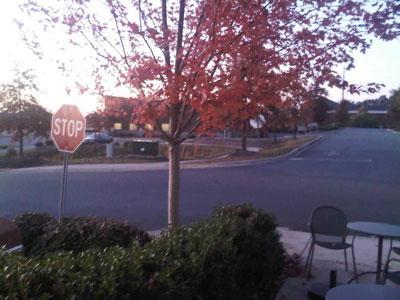
Without sufficient natural light.
The Bold ships with a 3.2-megapixel camera, and in our testing, image quality was on par with other 3.2-megapixel cameras in RIM's lineup, such as the Tour and Storm2. Provided the light was good, colors were crisp and rich. Thanks to the presence of a flash, most pictures are decent even in low light situations. The 9700 offers a 2x digital zoom, and though it's a departure from the 3x digital zoom found in the 9000, it wasn't noticeable. Camera features include the ability to customize the flash settings, autofocus, white balance, picture size (large, medium, or small), picture quality (superfine, fine, normal), color effect, geotagging, and the location to store the pictures. The video camcorder was decent; much like any device, it was fine for basic videos here and there, but isn't intended to replace your video camera.
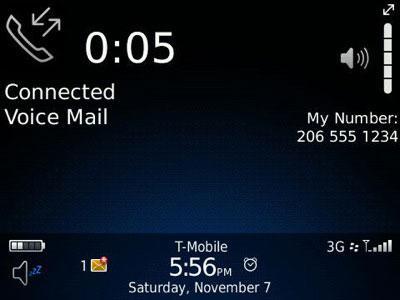
Call quality on the Bold 9700 was excellent.
We tested the Bold 9700 in both New York City and Charlotte using T-Mobile's 3G network, and call quality was spectacular. Callers had no problem hearing us, and call quality was clear on our end as well. When we went to a known T-Mobile fringe area, not only did the call sound very clear, but the 9700 maintained a 3G connection the entire time. We successfully paired the Plantronics Voyager Pro Bluetooth headset to the device, and Bluetooth functions performed well. Like any BlackBerry in recent memory, the 9700's speakerphone was clear and loud; I tested the device in a coffee shop, and I could hear the other party well. In return, though there was some reported background noise, my caller told me that they could understand the conversation. When testing T-Mobile's Hotspot @ Home service using the 9700's Wi-Fi connection, calls were crystal clear. Keep in mind that the Wi-Fi service still uses your T-Mobile plan minutes unless you're subscribed to the carrier's $10 monthly unlimited Hotspot calling feature.
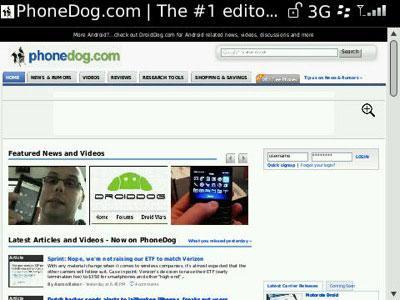
The browser, while improved, is still the Achilles' heel of the BlackBerry platform.
The Bold offers HSDPA connectivity, and internet speeds were great in testing. The PhoneDog homepage loaded in 24 seconds, and other data-intensive applications like BlackBerry Messenger, Poynt, and Bloomberg Mobile performed well. Though it has been improved in recent years, web browsing is still a bit annoying on the BlackBerry platform. Pages don't load nearly as well as more developed browsers, such as Safari on the iPhone and Webkit solutions found in Android and webOS.
Estimated talk time is 6 hours, and in testing, battery life was absolutely fantastic. With moderate to heavy use encompassing text messaging, calling, e-mail, web browsing, Wi-Fi, and Bluetooth, I was able to make it just under three days before the low battery warning flashed. Needless to say, very impressive for a 3G-enabled BlackBerry. The Bold 9700's battery rivals that of the Curve 8900 - it's that good. As with any device, battery numbers will vary with the level of usage that they're subjected to between charging cycles, but the 9700 is a travel warrior's dream phone, and is one of the best BlackBerry devices to date in the battery department.
With any revision comes a list of improvements that make the device better than its predecessors, and the BlackBerry Bold 9700 is no exception. If you're happy with the Bold 9000's size, older OS, battery life, and trackball, then you may not see a need to upgrade to the Bold 9700 when it launches in November. What I will tell anyone who's willing to listen is that I do see enough of an improvement in this device to warrant an upgrade from the original model. With a Curve-like size, newer OS pre-loaded, 3G connectivity, trackpad, stellar battery life, and an equally great keyboard, it's worth spending the money on.